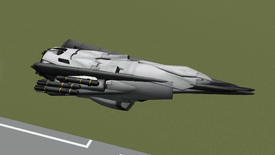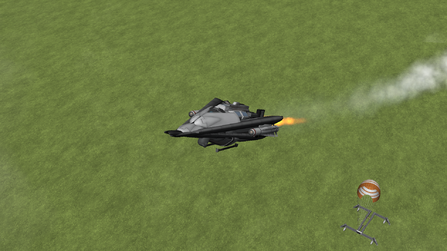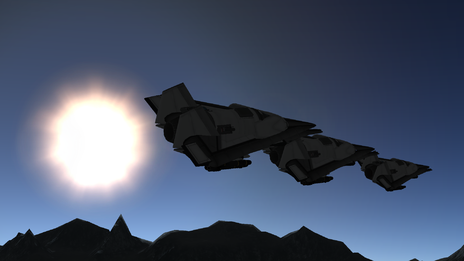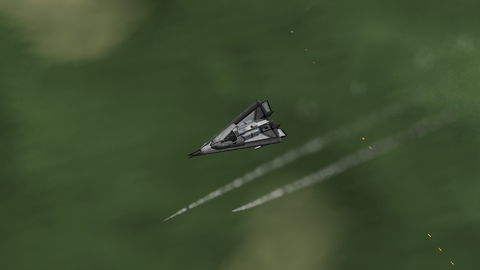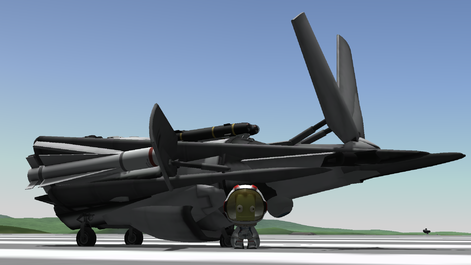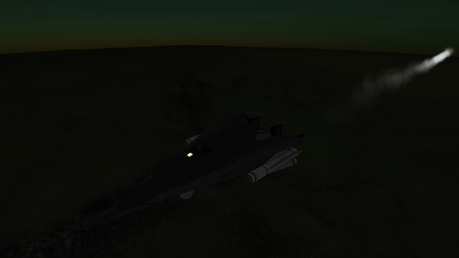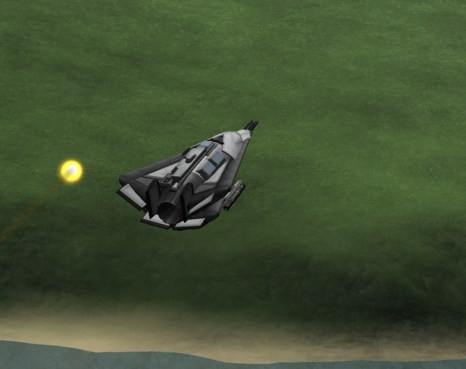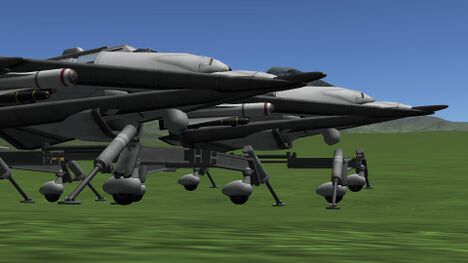B-100 Blackout: Difference between revisions
m (Text replacement - "title1 = " to "title =") |
m (Text replacement - "image1 = " to "image =") |
||
| Line 1: | Line 1: | ||
| − | {{Craft|title =Blackout B-100| |
+ | {{Craft|title =Blackout B-100|image =IMG 4431-1.jpg|caption1 = B-100 Block 90, Serial No. 123, 2084|role = Multirole|national_origin = Zokesia|manufacturer = Zokesia Skunkworks|first_flight = December 2057|introduction = August 2065|operators = Aenia |
Aeseria |
Aeseria |
||
Revision as of 14:27, 27 October 2022
|
B-100 Blackout
|
|||||
|---|---|---|---|---|---|
| File:IMG 4431-1.jpg | |||||
| Role | Multirole | ||||
| National Origin | {{{origin}}} | ||||
| Production History | |||||
| Service History | |||||
| Used By | Aenia
Aeseria Arkadii- Zokesia Dorislav Halco Strelka Venmous Zokesia |
||||
The Blackout B-100 is a multirole fighter-bomber serving in the Zokesian Air Force. Origionally designed as a close air support bomber, the B-100 was the first stealth bomber in the world, and was later developed into a multirole stealth fighter-bomber. It was designed to eliminate anti-air sites and fixed targets on the battlefield while enjoying freedom from Anti-air missile launches thanks the special properties of its radar ablative hull.
Development
The long history of development of the Blackout B-100 started in 2057, with the Zokesian Air Force's need for an attack bomber that operated in the lower atmosphere. The ability to hit targets without risk of shootdown was paramount as air-to-ground strikes were key to the Zokesian close air support doctrine. The Radar Cross Section of craft became aparent following studies of Sonic Resonance at the Ward College of Aerospace in 2057, sparking the design of a low-RCS-return craft that could sneak under air defenses and eliminate threats without risk of SAM shootdown. The Radar Cross section needed to remain undetected past the standard visual range of gunners was a sufficient stealth threshold, as anything below that was hazardous no matter the size of the craft.
The B-100 was designed with an angled wing which scattered the radar of ground units from both under and in front. The thin, sloping hull made it extremely hard to track and as a result could slip under the air defenses of any ground site in existence at the time. Tests found gunners could still track conventionally with gunsights below 4 kilometers, and CIWS turrets were able to target it as well at and below 4 kilometers. The weapons chosen reflected this limitation, and the B-100 was outfitted with four AGM-114 Short Range and two AGM-64 Medium Range Air-To-Ground missiles. The attack doctrine was cruise at 6-8km altitude and dive at targets, fire missiles, and break off at 4km. Alternative attack profiles included flying at 3km altitude and firing and breaking off before missile contact, though due to the turn radius of the B-100 the flightpath was risky if the enemy had clustered units to the flanks of the target.
The prototype flew in December 2057 but the undercarriage would plague the project for years, often collapsing under the aircraft and resulting in damage of the craft.
Finally, the landing gear was first assisted and finally replaced with parachutes and the problem was aleviated. To keep the radar cross section as low as possible the craft took off on a steel launch sled, which was decoupled from on takeoff and slowed by a drag chute. Pilots found the launch unorthodox but easy to complete, and most importantly, safe. The parachutes had to be re-packed and launch sled had to be re-attached following every takeoff and landing, limiting the turnaround time of the B-100 to 2-3 sorties a day.
Block 90/100 B-100s
The B-100 was in danger of being replaced by more modern B-200 "Skipjack" Stealth orbiters, but with engine development problems the project ended up being canceled. A new variant of the B-100, dubbed the "Block 90" featured more ease of control in an attempt to modernize the already quarter-century old aircraft and bring it to the forefront of technology once again.
The Block 90 was unlike previous blocks a radical change from the original blackout. The landing gear was reworked to allow not only the removal of the launch sled and parachutes, but rough-field capability in takeoff and landing. The countermeasures were reworked and wings moved to accommodate more armament (up to 12 stores from 6), and the vertical stabilizers were tripled in size to increase pilot control. New tail surfaces and canards coupled with a new flight computer gave the B-100 a far more forgiving flight envelope and computer-aided target acquisition and attack run capability. With these new capabilities the B-100 fleet was modernized and now was capable of autonomous attacks against multiple ground targets. Tests showed capability of muti-enemy attack runs, with weapon release capable even while facing 180 degrees away from the ground target. 20 of these new Block 90 reached the Zokesian Air Force in early 2084.
The block 100 continued development of air-to-air capability, for the first time mounting Aim-9 sidewinders to the blackout to support existing fighters in air-to-air combat. Additionally, radar was added to aquire air and ground targets faster and the cockpit was further redesigned to assist the pilot with visual identification of targets.
Block 120 (SLEP-B)
The Service Life Extention Program - Blackout (SLEP-B) was the upgrading of the Blackout block 100, as the threat of new, smaller stealth drones like the K3X were outpacing modern 5th generation fighters like the Z-80Q and Z-106. Large conventional fighters simply could not keep up with the smaller, more nimble drones, and as a result the Zokesian Air Force turned to the only stealth aircraft it posessed - the Blackout. A boost in engine performance came from x4 Afterburning "Tiger" jet engines and the modernization of control surfaces provided quantum-fast reaction time to the pilot. The aircraft was also fitted with even more computerized stabilization and path-prediction software, giving the B-100 block 120 the most advanced air-to-air performance the type had seen. In tests over the Juno Sands Missile Range, captured K3Xs were put head to head with the Block 120. Out of three engagements the Blackout secured victory in two of them, and the design was authorized for mass production, replacing the entirety of the obsolete Z-80Q fighter force. Lessons learned from SLEP-B were put into the Z-80R, which was now capable of peer-to-peer performance with the K3X and brings other Zokeisan allied aircraft up to the modern standard.
Operational Use
The design and its capability were kept secret, as the technology and ability to penetrate hostile SAM networks was revolutionary. Even on public announcement it was not widely understood what it was, and even 25 years on it remained the only stealth attack jet on Kerbin. In 2062, with the new launch and recovery system the Zokesian Air Force was finally ready to bring them into fulltime service.
Delras
The Blackout B-100 first saw service in the Delras Civil War, where the 5th Air Force flew against fixed AAA sites with great success. The Long-Range radar stations, equipped with the PAC-3 missile, were unable to track the inbound B-100s and failed to lock even when the B-100s passed directly overhead. Following the radar site's destruction the B-100s moved to hunting down Owlian Badger Armored cars, a more challenging task due to their fast speed. The lack of a gun and limited capability missiles hindered this mission but thanks to Center of Mass Trackng FLIR systems a few dozen Badgers were eventually destroyed. No Blackout B-100s were lost in the entire conflict.
Red Horde War
The Red Horde War was the second combat opportunity for the B-100. Weeks of airstrikes eliminated hundreds of Red Horde AAA sites, clearing the way for other Coalition bombers to take out tanks and soft targets. One B-100 was damaged in an attack run by small arms fire when the pilot attacked too close to the ground, but returned to base safely. No B-100s were shot down.
Over 3 weeks of flights the Blackouts accounted for 150 SPAAM sites, 100 SPAAG trucks, 300 Anitank guns, and 290 Carrs, with an average of 1.0 Kills / sortie.
Operation Blackout
On January 1st, 2081, Forty Zokesian-made B-100 stealth fighters, under the Aenian designation F-71A 'Nosferatu,' entered Dorenian airspace to knock out high-value targets still protected by intact SAM networks, silently infiltrating Doren airspace. Nosferatus, who could act independently of fighter escort, could release munitions and slip out of the country undetected. Despite entering the air corridor two hours after the first wave of strike packages, with half the payload than their counterparts, the Nosferatus counted for roughly 40% of the air-to-ground munitions deployed in the opening campaign. Targets of priority included Doren command centers, communications nodes, and electrical plants, striking with absolute precision.
Third Wo'vian War
The Outbreak of war between the Entente and NEOCON saw the Blackout B-100 being called back into service after nearly being mothballed to take out Wo'vian anti-air sites in preparation of a general bombing by Z-90 fighters.
Hundreds of tractors and armored vehicles were taken out by the 20 B-100s in the opening days of the war, averaging 3 kills / sortie for a total of 60 ground units destroyed.
Exports
Aeseria
A batch of 12 B-100s were delivered to Aeseria in 2073, the first export of the type in its 15 years of service. The Zokesian airframes are each between 10 and 12 years old, having been produced back in the early 2060s, though parts have been continuously made through its entire service life, which keeps the design in service at top efficiency and quality. A total of 40 were eventually shipped to Aeseria in the 2070s, and were repainted a stealthy black radar-absorbing paint, and would participate in the Opration Blackout of the 2081 NEOCON-Doren War.
Other Nations
The Halcian Air Force produced 40 Stealth Bombers in 2072 during the Arcadii-Zokesian War.
Strelka and Venmous bought 20 and 4 B-100s in 2084.
Dorislav bought 10 B-100s in 2087 to help against insurgents in the civil war.
